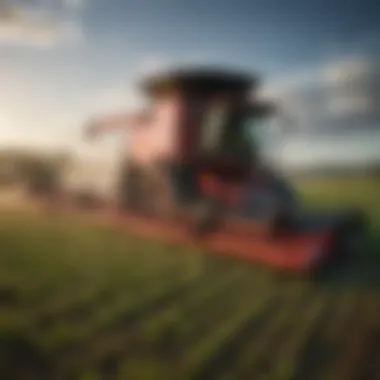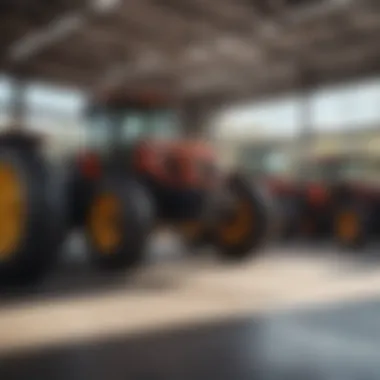Essential Agricultural Equipment in Central Kentucky


Intro
Central Kentucky plays a significant role in America's agricultural landscape. The region is not only famous for its horse farms but also for a variety of agricultural enterprises, including crops and livestock. To optimize productivity and ensure sustainability, farmers and enthusiasts rely heavily on agricultural equipment. This equipment ranges from traditional tractors to advanced harvesting machines. Understanding the landscape of agricultural machinery in Central Kentucky is essential for making informed decisions.
Key Concepts and Terminology
Definition of Terms
In the context of agricultural equipment, it is crucial to understand some key terms.
- Tractor: A powerful vehicle used for pulling farm implements.
- Combine Harvester: A machine designed to harvest crops, combining reaping, threshing, and winnowing processes.
- Cultivator: A tool used to prepare soil for sowing.
- Irrigation System: Methods and equipment used to supply water to crops.
These terms form the foundation of discussions about equipment in agriculture.
Overview of Relevant Practices
Effective use of equipment in farming involves several relevant practices. These include selecting the appropriate machinery for specific tasks, regular maintenance, and training operators on best practices.
- Selection: Choosing the right equipment based on job requirements and field conditions.
- Maintenance: Conducting regular checks and repairs to keep machinery in optimal working condition.
- Operator Training: Ensuring that individuals who operate machinery are well-trained to manage equipment safely and efficiently.
Current Trends and Innovations
Latest Research and Developments
The agricultural industry is witnessing ongoing research into more efficient equipment. Studies focus on enhancing fuel efficiency, improving machine durability, and reducing environmental impacts. Researchers at local universities often collaborate with equipment manufacturers to develop better solutions.
Emerging Technologies and Tools
New technologies are reshaping how Central Kentucky farmers operate. Innovations like GPS-guided tractors and drone-assisted crop monitoring are becoming standard. These tools allow for precision farming, where every square foot of land can be managed more effectively.
Practical Applications
Step-by-Step Guides
When it comes to utilizing equipment effectively, farmers benefit from step-by-step guides.
- Assess Your Needs: Determine what tasks you need to accomplish.
- Research Equipment: Look into different brands and models that suit your needs.
- Purchase or Lease: Decide if it is more economical to buy or lease equipment.
- Arrange for Training: Ensure that all operators receive proper training.
- Implement Maintenance Schedules: Set up a regular check for your machinery.
Troubleshooting Common Issues
Even the best equipment can face problems. Here are some common issues and simple troubleshooting steps:
- Engine Won’t Start: Check fuel levels and battery connections.
- Poor Performance: Inspect filters for clogs.
- Unusual Noises: Look for loose parts or signs of wear.
From understanding equipment terminology to applying innovative tools, this narrative aims to provide Central Kentucky's agricultural professionals and enthusiasts with a solid foundation for optimizing their operations.
Prelims to Central Kentucky Equipment
Understanding the central Kentucky equipment landscape is key for anyone involved in agriculture in this region. This area is known for its rich soil and diverse farming practices. Having the right tools is not just a benefit; it is almost a necessity. Equipment plays a significant role in enhancing productivity, ensuring sustainability, and making farming more efficient. Whether you are a seasoned farmer or a newcomer, knowing the types of equipment available and their specific uses can vastly improve operational success.
Overview of the Agricultural Landscape
Central Kentucky boasts a varied agricultural landscape. The terrain contributes to the growing of various crops, such as corn, soybeans, and tobacco. The region is also well-known for livestock farming, particularly in the equine industry. The agricultural practices here require specialized equipment to maintain productivity. From the rolling fields to the more uniform plots, climate and soil quality vary significantly, affecting the choice of machinery.
Many farmers engage in sustainable practices that not only focus on yield but also on environmental stewardship. This evolution in farming methods creates a demand for advanced tools and equipment suited for specific tasks. Thus, the agricultural horizon in central Kentucky is shaped not just by the natural landscape but also by the available technology and equipment.
Significance of Equipment in Agriculture
Equipment in agriculture serves a multitude of essential functions. First, it affects the efficiency and effectiveness of farming operations. For instance, using modern tractors can significantly reduce the time spent on fieldwork while improving the quality of the tasks performed. This translates to higher yields and better quality crops.


"The right equipment can turn challenging tasks into manageable ones, leading to increased productivity."
Second, the significance lies in the safety aspect. Modern machinery often includes safety features and ergonomic designs that minimize the risk of injury. Farmers operate heavy machinery daily, and having reliable equipment can prevent accidents and ensure worker safety. Third, equipment allows for precision in farming practices, which is essential in targeting soil and crop needs accurately.
In summary, understanding the importance of equipment in the agricultural sector cannot be overstated. It is intertwined with the goals of productivity, safety, and sustainability that define successful farming operations.
Types of Agricultural Equipment
Agricultural equipment plays a pivotal role in the efficiency and productivity of farming practices in Central Kentucky. This section highlights the diversity of equipment available to farmers, examining its various types and how each contributes to modern agriculture. Understanding these types is crucial for determining their use based on specific farming needs, enhancing productivity, and sustaining crop management practices.
Tractors and Their Varieties
Tractors serve as the backbone of any agricultural operation. These machines are essential for performing multiple tasks, such as plowing, tilling, and hauling. There are several varieties of tractors, each designed for specific functions:
- Row Crop Tractors: These are versatile and designed for a wide range of field operations.
- Utility Tractors: Smaller in size, these tractors are ideal for chores around the farm, including loading and hauling.
- Specialty Tractors: Tailored for unique tasks, they are often used in vineyards or orchards.
- 4WD Tractors: These provide excellent traction and power, suitable for working in challenging terrains.
The specific choice of tractor can significantly affect overall farm efficiency.
Harvesting Equipment
The harvest season is a critical time for farmers. Efficient harvesting equipment can directly influence the yield and quality of crops. Common types include:
- Combine Harvesters: These machines combine several processes, such as reaping and threshing, allowing for quicker collection of grain crops.
- Forage Harvesters: Ideal for cutting and processing forage crops like corn.
- Pickers and Grapple Harvesters: Used primarily for fruits and vegetables, ensuring minimal damage to delicate produce.
Investing in the right harvesting equipment is vital for maximizing harvest efficiency and minimizing waste.
Tillage and Cultivation Tools
Tillage tools prepare the soil for planting by breaking up and mixing soil layers. Various tools serve this purpose, including:
- Plows: Essential for breaking new ground by turning over the soil.
- Harrows: Used to smooth and level the soil surface after plowing, improving soil aeration.
- Cultivators: These tools help in weed control and soil aeration during the growing season.
Selecting the proper tillage equipment is important for crop production sustainability and soil health.
Planting and Seeding Machinery
Efficient planting is crucial for ensuring optimal crop growth. Seeding machinery is designed to place seeds in the soil at the correct depth and spacing. Key types include:
- Seeders: Basic machines that sow seed in the ground.
- Air Seeders: These use air pressure to distribute seeds uniformly over the field.
- Drills: More advanced than seeders, they provide precise seed placement in rows.
The right planting machinery can enhance seed germination rates and crop uniformity.
Spraying Equipment
Effective pest and weed management rely heavily on sprayers. Spraying equipment provides farmers with the ability to apply pesticides and fertilizers accurately. Common types include:
- Boom Sprayers: Ideal for large fields with row crops.
- Handheld Sprayers: Useful for smaller areas or spot treatments.
- Aerial Sprayers: These aircraft are utilized for extensive fields, allowing for even distribution over large areas.
Proper use of spraying equipment is vital for crop protection and overall farm health.
Irrigation Systems
In Central Kentucky, water management is essential for agriculture, making irrigation systems crucial. Various options include:
- Drip Irrigation: Targeted watering method that minimizes waste.
- Sprinkler Systems: Versatile, these systems can cover large areas and adapt to various crops.
- Surface Irrigation: Traditional method where water flows over the surface, suitable for specific field layouts.
Selecting the right irrigation system helps ensure water efficiency and improves crop yields.
Investing in appropriate agricultural equipment not only boosts productivity but also ensures sustainable farming practices that benefit Central Kentucky's economy.


Factors to Consider When Choosing Equipment
Choosing the right equipment is a pivotal decision for any agricultural operation. It directly influences productivity, efficiency, and ultimately, profitability. There are several key factors to weigh before making an investment, including land and crop needs, budget limitations, and the availability and quality of options on the market.
Assessing Land and Crop Needs
Understanding the unique requirements of your land and the type of crops you are growing is essential. Different crops require different farming techniques and machinery configurations. For instance, row-crop farming may demand specific planting machinery, while livestock operations may benefit from equipment designed for fodder production.
When evaluating land, consider its size, topography, and current condition. Factors such as soil type and drainage capabilities can dictate necessary equipment features. Moreover, the scale of operations should align with the equipment capabilities. Farmers should analyze whether larger tractors are justified for expansive fields or if compact models can improve maneuverability in smaller areas.
Budgetary Constraints
Budget restrictions are always present and challenge farmers to maximize their investments. When selecting equipment, it is critical to determine the total cost of ownership, not just the purchase price. This includes maintenance costs, fuel consumption, and potential financing options.
Create a detailed financial plan that prioritizes essential equipment over luxury options. Consider the long-term benefits of high-quality equipment that may have a higher upfront cost but lower long-term operating costs. Evaluate whether leasing or purchasing suits your financial situation better. Prioritize versatile equipment that can handle multiple tasks, which can reduce the need for additional purchases.
Equipment Availability and Quality
Assessing what is available in the market is another critical step. Research local dealers and online marketplaces to find the best quality equipment suited for your needs. Read customer feedback and reviews to gauge reliability and performance. Durable equipment can withstand rigorous agricultural tasks and should be a priority in your decision-making process.
Beyond just availability, consider the reputation of the brands. Established brands like John Deere and Case IH often provide robust support and a vast network of service resources. Ensure that you have access to parts and repair services in your area, as this can minimize downtime in critical farming operations. Prioritize equipment that meets industry standards while also exploring innovative options that may enhance efficiency without compromising quality.
"Careful selection of equipment can streamline operations, increase yields, and ultimately boost the profitability of agricultural endeavors."
By systematically evaluating land and crop needs, budgeting wisely, and ensuring the availability of reliable equipment, farmers in Central Kentucky can make informed decisions that positively impact their agricultural operations.
Maintenance and Care of Equipment
Caring for agricultural equipment is not just a matter of keeping machines running; it directly affects productivity and efficiency on farms in Central Kentucky. Proper maintenance ensures the longevity of equipment while reducing unexpected breakdowns. This topic is significant as farmers rely heavily on their tools for daily operations, and neglect can lead to costly frustrations.
Routine maintenance can help in identifying potential issues before they escalate. It's not merely about adhering to a schedule but also about understanding the needs of different types of equipment. Effective care has benefits like optimizing performance and ensuring safety on the farm. It's crucial to approach maintenance with a strategy that accommodates the specific requirements of each piece of machinery.
Routine Maintenance Practices
Regular routine maintenance practices are essential for keeping equipment in optimal working condition. These practices include:
- Cleaning machinery regularly - Dirt and debris can hinder performance. A clean machine performs better and remains operational longer.
- Lubricating moving parts - Proper lubrication minimizes wear and tear, which is critical for mechanical components.
- Checking fluid levels - Fluids such as oil, coolant, and hydraulic fluid must be at the right levels to avoid overheating and other issues.
- Replacing filters - Air and fuel filters need to be replaced regularly to keep engines running efficiently.
By making routine maintenance a priority, farmers can better avoid unexpected down times during the planting and harvesting seasons.
Importance of Regular Inspections
Regular inspections play a vital role in the care of agricultural equipment. An inspection can reveal hidden problems that routine cleaning or maintenance might not uncover. These inspections can be performed personally or by hiring professionals.
Key points about regular inspections include:
- They allow for early detection of wear and tear, preventing minor issues from developing into major repairs.
- Inspections can ensure safety standards are upheld, especially for equipment that is heavy or complex.
- Conducting inspections promotes a culture of safety, which is critical in maintaining a safe working environment.
Given the investment in agricultural machinery, conducting regular inspections is both a financially wise and operationally sound decision.
Common Repair Needs
Equipment may inevitably encounter problems that require repair. Some common repair needs to anticipate include:
- Engine issues - Signs often include reduced power or unusual noises. Timely attention is essential for engine repairs to prevent more severe damage.
- Transmission problems - Issues can manifest through difficulty shifting gears or unusual sounds, signaling a need for immediate assessment.
- Hydraulic system malfunctions - These can impact lifting mechanisms. Problems may arise due to leaks or failures in hydraulic lines.
- Tires and tracks - Regular checks for proper inflation and tread conditions are necessary, as they influence performance and safety.
Ensuring these common repairs are addressed promptly can save time, costs, and effort in the long run. By embracing a proactive maintenance approach, farmers in Central Kentucky will ensure their operations are not only efficient but also sustainable.
The Economic Impact of Equipment in Central Kentucky


The economic landscape of Central Kentucky cannot be understood without acknowledging the critical role that agricultural equipment plays. This equipment is not only essential for productivity in farming but also acts as a catalyst for economic growth. From boosting local businesses to influencing employment rates, the impact is substantial.
Contributions to Local Economy
Agricultural equipment contributes significantly to the local economy in Central Kentucky. Local suppliers and manufacturers of equipment such as the John Deere and Kubota, directly benefit from increased demand. These companies provide vital services like sales, parts, and maintenance.
Moreover, the acquisition of new equipment supports local manufacturers and stimulates sales for parts and services. This creates a ripple effect where money circulates within communities. Events, such as agricultural fairs and exhibitions, promote these brands and educate farmers about innovative technologies.
Importantly, having access to high-quality equipment allows farmers to increase their yield, thereby improving their profit margins and reinvesting into their farms. Such practices enable farmers to contribute positively to their local economies, ensuring sustainability and growth.
Job Creation and Skill Development
The presence of advanced agricultural equipment has a direct effect on job creation in Central Kentucky. Equipment manufacturers, repair shops, and dealerships create jobs in both skilled and unskilled labor. Mechanics, sales representatives, and customer service staff are essential roles that emerge within these companies.
Job training programs also flourish alongside equipment advancements. Educational institutions may collaborate with local businesses to develop curriculums focused on machinery management and maintenance. These programs enhance the skill set of the workforce, preparing them for greater responsibilities.
Moreover, skilled laborers are in demand as new technologies emerge. Farmers increasingly seek workers with the knowledge to operate sophisticated machinery. This demand encourages local training initiatives and enhances overall skill levels in the workforce.
"Economic development in agriculture is not just about bigger yields. It's about stronger communities and better opportunities for the people inhabiting them."
Future Trends in Agricultural Equipment
The agricultural sector is evolving rapidly, and understanding future trends in agricultural equipment is crucial for those involved in farming and agribusiness. Central Kentucky, known for its rich farmland, is embracing these trends to improve productivity and sustainability. Keeping an eye on upcoming developments can help farmers and agricultural professionals make informed decisions about their operations. This section discusses key advancements and practices shaping the future of agricultural equipment.
Technological Advancements
The impact of technology on agriculture is undeniable. Farmers are increasingly utilizing modern equipment that incorporates advanced technology. These include features like GPS systems, drones, and automation. GPS-guided tractors enable farmers to optimize their planting and harvesting processes. Similarly, drones are used for crop monitoring, giving farmers real-time data on the health of their fields.
The following technological advancements are noteworthy:
- Precision Agriculture: This involves using data to manage variability in crops. It helps farmers apply fertilizers and pesticides only where needed, reducing waste and increasing efficiency.
- Autonomous Machinery: Self-driving tractors and automated systems are becoming more common, allowing farmers to focus more on strategy rather than manual labor.
- Data Analytics: Collecting data through various tools can give insights into crop performance, helping farmers make better decisions on resource allocation.
Implementing these technologies not only enhances productivity but also significantly reduces labor costs. The shift towards smart farming can yield better returns in a competitive marketplace.
Sustainability and Eco-friendly Practices
As the urgency for sustainability increases, farmers in Central Kentucky are adopting eco-friendly practices within their equipment choices.
Using sustainable equipment has manifold benefits:
- Reduced Carbon Footprint: Innovative machinery designs consume less fuel and produce fewer emissions, contributing to a healthier environment.
- Organic Farming Tools: Equipment designed for organic farming is gaining popularity. They help farmers grow crops without synthetic fertilizers and pesticides, aligning agricultural practices with environmental consciousness.
- Energy-efficient Systems: Innovations such as solar-powered irrigation systems are becoming more accessible and are being adopted by progressive farming operations.
Farmers are increasingly recognizing that sustainable practices are not only good for the environment but can also lead to profitability in the long term. "Sustainability in agriculture is not just a trend; it's a necessary evolution that aligns farming practices with environmental stewardship."
Closure
In this section, we will underline the significance of understanding agricultural equipment in Central Kentucky. This overview plays a pivotal role in shaping how farmers and agricultural businesses approach their practices. Recognizing the impact of equipment on productivity and sustainability is essential for adapting to modern challenges. Awareness of technological trends ensures that stakeholders are not left behind in a rapidly evolving industry.
Summary of Key Points
Key points from this article provide clarity on several important aspects:
- The diversity of agricultural equipment available in Central Kentucky.
- Considerations for selecting the right tools, including land needs and budget.
- Importance of regular maintenance to prolong equipment lifespan.
- Economic benefits of equipment usage within the local agri-business sector.
- Emerging technologies that promise to enhance efficiencies in farming practices.
Each of these points highlights the significant role that equipment plays in not only enhancing productivity but also enriching the local economy and workforce.
Call to Engage with Technology
Engagement with technological advancements in agricultural equipment is increasingly vital. Farmers and agricultural professionals must embrace modern tools that are available. Utilizing new machines and techniques can lead to better yields and less environmental impact.
Investing time in understanding these technologies can facilitate integration into daily operations. Staying informed about innovations, participating in demonstrations, and connecting with fellow professionals will provide insights into best practices. Thus, it becomes essential to not only adapt but actively seek advancements that align with sustainable goals in agriculture.
"The future of agriculture is not merely in the hands of tradition, but in the innovations that pave new paths for growth."
This perspective serves as a reminder that continuous learning and adaptation are crucial for success in modern agriculture.







